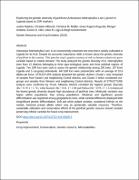| dc.contributor.author | Nakintu, Justine | |
| dc.contributor.author | Albrecht, Christian | |
| dc.contributor.author | Müller, Christina M. | |
| dc.contributor.author | Kagoro-Rugunda, Grace | |
| dc.contributor.author | Andama, Morgan | |
| dc.contributor.author | Olet, Eunice A. | |
| dc.contributor.author | Lejju, Julius B. | |
| dc.contributor.author | Gemeinholzer, Birgit | |
| dc.date.accessioned | 2020-02-11T06:56:44Z | |
| dc.date.available | 2020-02-11T06:56:44Z | |
| dc.date.issued | 2019 | |
| dc.identifier.citation | Nakintu, J., Albrecht, C., Müller, C. M., Kagoro-Rugunda, G., Andama, M., Olet, E. A., Lejju, J. B., & Gemeinholzer, B. (2019). Exploring the genetic diversity of jackfruit (Artocarpus heterophyllus Lam.) grown in Uganda based on SSR markers. Genetic Resources and Crop Evolution. https://doi.org/10.1007/s10722-019-00830-5 | en_US |
| dc.identifier.issn | 0925-9864 (Print) | |
| dc.identifier.issn | 1573-5109 (Online) | |
| dc.identifier.uri | http://dir.muni.ac.ug/xmlui/handle/20.500.12260/331 | |
| dc.description.abstract | Artocarpus heterophyllus Lam. is an economically important tree crop that is widely cultivated in Uganda for its fruit. Despite its economic importance, little is known about the genetic diversity of jackfruit in the country. This puts the crop’s genetic resource at risk as farmers selectively grow varieties based on market demand. The study analyzed the genetic diversity of A. heterophyllus
trees from 12 districts belonging to three agro-ecological zones and three political regions of Uganda. Ten SSR loci were used to assess the genetic relationship among 200 trees, 197 from Uganda and 3 out-group individuals. All SSR loci were polymorphic with an average of 10.9 alleles per locus. STRUCTURE analysis proposed two genetic clusters: Cluster 1 was composed of samples from Eastern and neighboring Central districts, and Cluster 2 which constituted out-groups and samples from Western and neighboring Central districts. Results of STRUCTURE analysis were confirmed by PCoA. Mbarara District exhibited the highest genetic diversity (He = 0.79, I = 1.71), while Kamuli (He = 0.61, I = 1.08 and Pallisa (He = 0.59, I = 1.12) displayed the lowest genetic diversity despite high abundances of jackfruit trees. Molecular variation was higher within populations than among populations. Moderate and significant genetic differentiation was registered among geographical zones, while varietal differences displayed little insignificant genetic differentiation. Soft and white pulped varieties, considered inferior on the market, harbored private alleles which may be genetically valuable resources. Therefore, sustainable utilization and conservation efforts of the jackfruit genetic resource should consider preserving inferior varieties for future crop improvement. | en_US |
| dc.description.sponsorship | DAAD and Institute of Systematic Botany, Justus-Liebig-University, Giessen, Germany | en_US |
| dc.language.iso | en | en_US |
| dc.publisher | Genetic Resources and Crop Evolution | en_US |
| dc.subject | Crop improvement | en_US |
| dc.subject | Conservation | en_US |
| dc.subject | Genetic resource | en_US |
| dc.subject | Microsatellites | en_US |
| dc.title | Exploring the genetic diversity of jackfruit (Artocarpus heterophyllus Lam.) grown in Uganda based on SSR markers | en_US |
| dc.type | Article | en_US |

